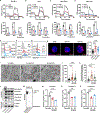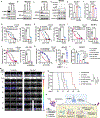ALKBH1 Drives Tumorigenesis and Drug Resistance via tRNA-decoding Reprogramming and Codon-biased Translation
- PMID: 40747882
- PMCID: PMC12377461
- DOI: 10.1158/2159-8290.CD-24-1043
ALKBH1 Drives Tumorigenesis and Drug Resistance via tRNA-decoding Reprogramming and Codon-biased Translation
Abstract
Cancer cells utilize codon-biased translation to fuel tumorigenesis and drug resistance; however, underlying mechanisms remain poorly understood. In this study, we show that ALKBH1 is overexpressed in acute myeloid leukemia (AML) and essential for leukemia stem cell/leukemia-initiating cell self-renewal and AML development/maintenance but dispensable for normal hematopoiesis. ALKBH1 enhances mitochondrial assembly/function and oxidative phosphorylation, crucial for AML survival/proliferation and resistance to venetoclax, a potent BCL2 inhibitor and widely used first-line targeted therapy for AML in the clinic. Mechanistically, ALKBH1 catalyzes 5-formylcytosine at tRNA wobble positions, reprograming decoding and facilitating codon-biased translation, a mechanism we term "epitranslatomic Midas touch," which in turn drives leukemogenesis and drug resistance by promoting the synthesis of key oncogenic proteins like WDR43. Targeting ALKBH1, particularly together with venetoclax, exhibited potent antileukemia efficacy in preclinical models with favorable safety profiles. Collectively, our findings elucidate ALKBH1's pivotal role in codon-biased translation and tumorigenesis and propose a novel therapeutic strategy for cancer treatment.
Significance: This study uncovers that ALKBH1-driven tRNA-decoding reprogramming and codon-biased translation, termed "epitranslatomic Midas touch," is crucial for leukemogenesis, leukemia stem cell/leukemia-initiating cell self-renewal, mitochondria structure/function, and resistance to venetoclax. Targeting ALKBH1, especially in combination with venetoclax, offers a promising therapeutic strategy to combat drug resistance in AML and potentially other ALKBH1-overexpressing cancers.
©2025 American Association for Cancer Research.
Figures







References
MeSH terms
Substances
Grants and funding
LinkOut - more resources
Full Text Sources
Medical

